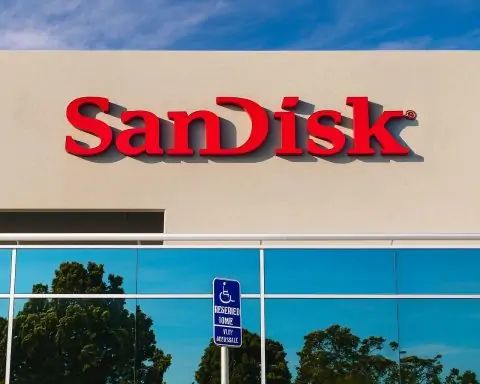Intel stock (NASDAQ: INTC) heads into Monday’s session sitting just below the middle of its recent range, after a week dominated by foundry doubts, a high‑profile TSMC trade‑secret probe, and ongoing debate about whether 2025’s huge rally has already gone “too far, too fast.”
If you’re watching Intel before the U.S. stock market opens on Monday, November 24, 2025, here’s what actually matters right now.
1. Where Intel stock stands after Friday’s close
- Last close (Friday, Nov. 21): Intel finished at $34.50, up about 2.6% on the day after trading as high as $34.98 and rebounding from Thursday’s drop. [1]
- Recent trading range: The stock is moving in a 52‑week band of roughly $17.67 to $42.48, putting Friday’s close in the middle of that range. [2]
- Market value: At these levels, Intel is worth about $160–165 billion, with a sky‑high reported P/E ratio in the thousands because earnings over the last year were near zero on a GAAP basis. [3]
In other words, Intel is no longer the bargain it was in early 2025, but it’s also fallen back from the post‑earnings highs near the low‑$40s reached in late October. [4]
2. A huge 2025 comeback — with a recent pullback
Intel has staged one of 2025’s biggest turnarounds:
- Over the last 12 months, total return (including dividends) is around +41%. [5]
- Year‑to‑date, estimates cluster around +65–75%, depending on the data source and whether dividends are included. [6]
But the rally has cooled sharply:
- Zacks notes Intel shares are down about 11–12% over the past month, compared with a roughly 3% drop in the S&P 500 over the same period. [7]
- Research from Simply Wall St highlights that after a year‑to‑date gain of roughly 66%, the stock recently slipped 6–12% over the last week and month as investors reassess valuation. [8]
Takeaway for Monday: Intel enters the new week as a big 2025 winner that’s now consolidating, which makes it more sensitive to news that either confirms—or challenges—the turnaround narrative.
3. Q3 2025 earnings: back to profit, but not all from operations
Intel’s third‑quarter 2025 results (reported October 23) were the turning point that ignited October’s surge:
- Revenue: About $13.7 billion, up ~3% year over year and ahead of consensus near $13.1–13.2 billion. [9]
- GAAP earnings: Net income of $4.1 billion, or ~$0.90 per share, versus a $17 billion loss a year earlier. [10]
- Non‑GAAP/adjusted EPS: Around $0.23 per share, far above earlier expectations that hovered near breakeven or a small loss. [11]
There are two important nuances heading into Monday:
- One‑offs helped a lot. A big chunk of that profit came from asset sales, including the majority stake sale of Altera and part of Intel’s Mobileye holding, rather than pure operating strength. [12]
- Guidance is still cautious. Intel guided Q4 2025 revenue to $12.8–13.8 billion and non‑GAAP EPS around $0.08, and some research houses still expect full‑year EPS around –$0.11, highlighting that 2025 is a transition year, not a full recovery. [13]
What it means for Monday: The market now knows Intel can beat expectations, but investors are watching closely to see whether the Q3 rebound can repeat without large, one‑time boosts.
4. Big‑ticket backers: Nvidia, SoftBank and the U.S. government
A unique part of the Intel story in late 2025 is who owns it now:
- Nvidia investment: In September, Nvidia agreed to invest $5 billion in Intel common stock and co‑develop chips for data centers and PCs, including x86 system‑on‑chips that integrate Nvidia RTX GPU chiplets. [14]
- SoftBank stake: In August, SoftBank signed a deal to invest $2 billion into Intel shares, becoming one of Intel’s largest shareholders while not seeking a board seat or chip‑purchase commitments. [15]
- U.S. government equity stake: Through an amended CHIPS Act agreement, Washington is taking roughly a 9.9–10% stake in Intel, funded by about $5.7 billion in remaining CHIPS grants plus additional program support, bringing total federal backing to more than $11 billion. [16]
Together with the Altera deal, analysts often frame this as roughly $15+ billion in fresh capital and de‑risking, helping Intel fund its fab build‑out and turnaround. [17]
Why it matters now: These heavyweight investors are part lifeline, part pressure. Monday’s trading will continue to reflect whether the market thinks this new capital is fuel for a durable comeback or a bailout that pulled forward too much optimism.
5. Foundry ambitions vs. new skepticism from Citi
Intel wants its Intel Foundry business to challenge TSMC and Samsung, but late‑week headlines added doubts:
- A Citi research note circulated around November 20 said that while major chipmakers like Qualcomm, Apple and Broadcom are evaluating Intel’s foundry and packaging services, the bank still doesn’t expect the strategy to gain major traction. [18]
- Citi and other commentators point to reports that Nvidia walked away from at least one advanced packaging project with Intel, raising concerns about execution and competitiveness versus TSMC’s and Samsung’s more mature nodes. [19]
More broadly:
- Intel itself has said that 18A yields and financial performance won’t reach target levels until around 2027, even as it pushes to bring foundry customers on board. [20]
Foundry skepticism helped drive a sharp 4.2% drop in Intel shares on Thursday (Nov. 20) before Friday’s rebound. [21]
What to watch on Monday: Any additional analyst notes, client announcements or commentary on Intel Foundry could quickly move the stock, given how central the foundry plan is to the long‑term story.
6. TSMC trade‑secret probe: headline risk, not numbers (yet)
Another overhang heading into the new week is Intel’s involvement in a high‑profile Taiwanese investigation:
- Taiwan is probing whether former TSMC senior executive Wei‑Jen Lo, who joined Intel as a vice president of R&D in October, may have taken confidential materials related to TSMC’s advanced N2 and A‑series nodes. [22]
- Intel CEO Lip‑Bu Tan has publicly denied that Intel has or will use any misappropriated trade secrets, calling the allegations “rumor and speculation” and stressing Intel’s respect for intellectual property. [23]
So far:
- There’s no public evidence that Intel benefited from stolen IP, and TSMC’s own internal investigation is ongoing. [24]
- Analysts mostly see the issue as a reputational and legal‑risk story that could, in a worst‑case scenario, slow cooperation with Asian partners or trigger penalties—but it doesn’t yet affect near‑term revenue estimates.
For Monday’s open: Any new headlines out of Taiwan or TSMC could add short‑term volatility, even if they don’t change fundamentals right away.
7. Strategy update: 18A, Panther Lake and the AI PC push
Intel’s turnaround hinges on regaining manufacturing leadership and riding the AI PC wave:
- Intel says its 18A node—with RibbonFET transistors and PowerVia backside power delivery—is on track for production in 2025, positioning it as a leading‑edge process for AI and high‑performance computing. [25]
- The company has unveiled Panther Lake, its first AI PC platform built on 18A, slated for high‑volume production at its new Arizona fab and broad availability starting around year‑end into early 2026. [26]
- Q3 results showed a rebound in the Client Computing Group (PC chips), helped by Windows refresh cycles and early demand for AI‑capable PCs, with revenue in that segment rising low‑single‑digits year over year. [27]
On the server and AI side:
- Intel is ramping its Xeon 6 and “Granite Rapids” lines while it works on more advanced designs like Clearwater Forest, now pushed into 2026 due to complex packaging requirements. [28]
Why this matters before the bell: Monday’s trading will still be driven by perceptions about execution—whether Intel can actually deliver 18A at scale and on time, and whether AI PCs and data‑center chips translate into sustained revenue growth rather than just a one‑quarter pop.
8. AI leadership shake‑up after OpenAI hire
Intel’s internal org chart is also in flux:
- Earlier in November, Intel confirmed that Sachin Katti, who had been leading its AI efforts after a January reorganization, left the company to join OpenAI. [29]
- CEO Lip‑Bu Tan will now directly oversee Intel’s AI and Advanced Technologies Groups, which centralizes control but also adds more to his already heavy workload. [30]
For investors, the shift cuts both ways:
- On one hand, having the CEO personally steering AI strategy signals how critical AI is to Intel’s future.
- On the other, losing a high‑profile AI leader to a top AI lab underlines why skeptics still argue that Intel is behind Nvidia and others in AI‑specific workloads. [31]
Into Monday’s session: Any new hires, reorganizations or product‑roadmap details on the AI side could help reassure the market that Intel isn’t just reliant on external capital but is building a credible in‑house AI roadmap.
9. What Wall Street and big money are doing with INTC
Analyst consensus: cautious, not euphoric
Wall Street’s view has shifted from “deep value” to “show me more”:
- MarketBeat’s aggregation of 30‑plus analysts shows a consensus rating of “Reduce” (effectively a mild “sell”) with an average 12‑month price target around $34.84, only about 1% above Friday’s close. The mix skews heavily to Hold, with a handful of Buys and several Sells. [32]
- Another aggregator, StockAnalysis, lists a more neutral “Hold” consensus and an average target near $31.98, implying modest downside from current levels. [33]
Several big‑name brokers have raised price targets into the $35–50 range after Q3’s beat, but others—like HSBC and Bank of America—have downgraded the stock, warning that the rally may be ahead of fundamentals. [34]
Institutional flows: some trimming, some buying
Recent regulatory filings and fund reports show a mixed but active institutional picture:
- Empowered Funds LLC cut its Intel position by nearly 47% in Q2, even as other large holders like Nuveen, Price T. Rowe and Goldman Sachs increased or initiated sizable stakes. [35]
- Rhumbline Advisers modestly increased its holdings to more than 8 million shares, while Magnetar Financial initiated a new position of about 64,000 shares. [36]
- Across the shareholder base, institutional ownership is roughly 64–65%, reflecting heavy involvement from funds and long‑term investors. [37]
What this suggests for Monday: Intel is no longer an under‑owned contrarian bet. With the stock close to many analysts’ targets, new information—good or bad—can have an outsized impact as institutions rebalance.
10. Key things to watch when markets open on November 24, 2025
Here’s a concise checklist for Monday’s open if you’re tracking Intel stock:
- Pre‑market and early volume
- Watch whether INTC trades meaningfully away from Friday’s $34.50 close in pre‑market activity and whether early volume spikes above normal levels (~100 million shares on busy days recently). [38]
- Fresh headlines on the TSMC investigation
- Any statement from TSMC, Taiwanese authorities, or Intel could swing sentiment, especially if it hints at legal exposure or restrictions on future cooperation. [39]
- Follow‑up commentary on Citi’s foundry note
- Look for other banks confirming or challenging Citi’s skepticism about Intel Foundry, as this directly affects how investors model long‑term margins and capital needs. [40]
- Signals on 18A, Panther Lake and fab timelines
- Any update on 18A yields, Arizona fab ramp, or Panther Lake AI PC launch timing will be scrutinized as proof of execution—or lack of it. [41]
- Broader semiconductor sentiment
- Intel often trades in sympathy with peers like Nvidia (NVDA), AMD (AMD), and TSMC (TSM); sharp moves in AI or PC‑linked names ahead of the open can spill into INTC even without company‑specific news. [42]
- Macro and rates backdrop
- After a big 2025 rally in cyclicals and AI stocks, any new macro data that shifts expectations for Fed rate cuts or tariffs tends to hit semiconductors quickly, especially names like Intel that are seen as turnaround plays rather than pure secular growth. [43]
Bottom line
Heading into Monday, November 24, 2025, Intel is:
- Financially stronger than a year ago, with Q3 profits back in the black and major outside capital from Nvidia, SoftBank and the U.S. government. [44]
- Strategically ambitious, betting its future on 18A, AI PCs, and a revived foundry business. [45]
- But also priced for a lot of success already, with analysts divided, foundry execution in question, and new headline risk from the TSMC probe. [46]
For anyone watching INTC at the open, the key question isn’t whether Intel has started a turnaround—that part is visible in the numbers. It’s whether Monday’s news flow and the weeks ahead will show enough sustained execution to justify a stock that has already staged one of 2025’s biggest rebounds.
This article is for informational and educational purposes only and does not constitute financial or investment advice. Consider your own objectives and risk tolerance, or consult a licensed financial professional, before making any investment decisions.
References
1. www.marketbeat.com, 2. www.marketbeat.com, 3. www.marketbeat.com, 4. www.investing.com, 5. www.financecharts.com, 6. www.financecharts.com, 7. www.zacks.com, 8. simplywall.st, 9. www.gurufocus.com, 10. apnews.com, 11. macrospire.com, 12. www.tomshardware.com, 13. roboforex.com, 14. nvidianews.nvidia.com, 15. www.intc.com, 16. www.reuters.com, 17. apnews.com, 18. markets.financialcontent.com, 19. finance.yahoo.com, 20. www.reuters.com, 21. www.marketbeat.com, 22. www.tomshardware.com, 23. www.bloomberg.com, 24. www.trendforce.com, 25. newsroom.intel.com, 26. www.intc.com, 27. www.reuters.com, 28. www.reuters.com, 29. www.reuters.com, 30. www.reuters.com, 31. www.fool.com, 32. www.marketbeat.com, 33. stockanalysis.com, 34. www.barrons.com, 35. www.marketbeat.com, 36. www.marketbeat.com, 37. www.marketbeat.com, 38. www.schwab.wallst.com, 39. www.trendforce.com, 40. markets.financialcontent.com, 41. newsroom.intel.com, 42. www.businessinsider.com, 43. www.investopedia.com, 44. apnews.com, 45. newsroom.intel.com, 46. www.marketbeat.com







